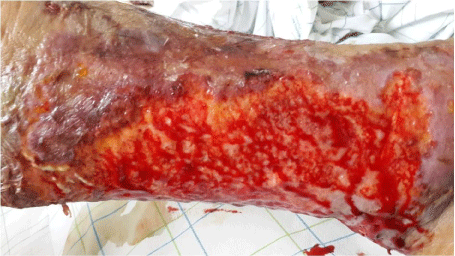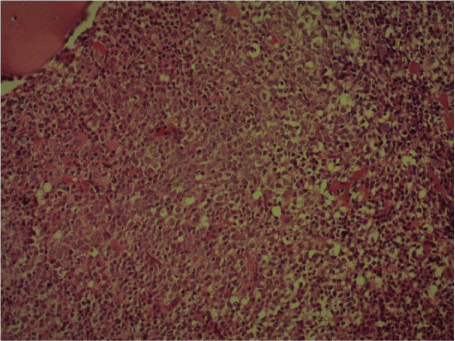Tamoxifen is an anti estrogen recommended in the treatment of estrogendé pendants cancers. Its side effects are rare and haematological toxicity is extremely rare. We relate an original case of severe erysipelas which revealed a toxic myelopathy to tamoxifen.
Erysipelas, Tamoxifen, Breast cancer, Hematotoxicity
Tamoxifen is an anti estrogen recommended in the treatment of estrogen-dependent cancers. Its side effects are rare and its haematological toxicity is extremely rare. We present an original case since it is the first that brings a deep bicytopenia to tamoxifen, with its diagnostic and therapeutic difficulties.
A 43-year-old woman, with history of breast cancer under hormone therapy by Tamoxifen for three years, consulted for bullous hemorrhagic and necrotic erysipelas in the left leg, lasting for a week in a context of fever and poor general condition (Figures 1 and Figure 2).
Complete blood counts objectified deep center bicytopenia (anemia at 5.6 g/dl and thrombocytopenia at 10,000/mm3). Médullogramme showed a very average wealth of marrow with few and dystrophic megakaryocytes. Bone marrow biopsy objectified bone marrow hyperplasia with signs of dysmyelopoiesis, PRCA and densification of the reticulin network can be compared with a toxic myelopathy (Figure 3). Immunohistochemistry showed a reaction marrow hyperplasia with absence of bone marrow infiltration (Figures 4 and Figure 5) and pharmacovigilance center concluded to direct toxicity of tamoxifen.
The patient received treatment with the antibiotic, wound care, multiple transfusions and substitution Tamoxifen by anti-aromatase. The outcome was favorable with a decline of 2 years.
Tamoxifen is an anti estrogen recommended in the treatment of cancers estrogen-dependent when hormone receptors are positive [1]. Its undesirable effects are rare in type of endometrial cancer, thromboembolic events, hot flushes and mood disorders [2], its hematologic toxicity remains extremely rare in leukopenia type sometimes associated with anemia and/or thrombocytopenia, exceptionally neutropenia severe [3].
Our case is original since it is the first that reports a very deep bicytopenia to Tamoxifen, with its diagnostic and especially therapeutic difficulties. Thus, an iatrogenic to other anti-cancer treatments (chemotherapy and radiotherapy) was quickly dismissed by a monitoring hemogram which was normal, likewise a macrophage activation syndrome has was also mentioned in front of the rapid deglobulization and the presence of some stigmata but the medullogram showed no signs of hemophagocytosis, in addition, the osteomedullary biopsy with an immunohistochemical study distanced an infiltration medullary and were in favor of toxic myelopathy, which was confirmed by the pharmacovigilance.
The management of our patient was difficult which required a rigorous multidisciplinary collaboration between dermatologist, internist, hematologist, pathologist, oncologist, transfusion center and pharmacovigilance center.
Tamoxifene is a drug that is not devoid of particularly hematological side effects. Its prescription in this particularly precarious terrain must be careful.

Figure 1: Bullous and necrotic erysipelas.

Figure 2: Hemorrhagic erysipelas.

Figure 3: Bone marrow biopsy (HE x200) showing a marrow hyperplasia with dysmyélopoise signs.

Figure 4: Bone marrow biopsy (IHC CD34) eliminating bone marrow infiltration.

Figure 5: Panel E: Bone marrow biopsy (IHC MPO) eliminating myelodysplasia.